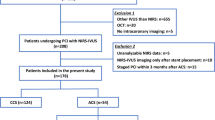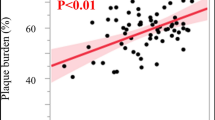Abstract
Elevated serum uric acid level was reportedly associated with greater coronary lipid plaque. Xanthine oxidoreductase (XOR) is a rate-limiting enzyme in purine metabolism and believed to play an important role in coronary atherosclerosis. However, the relation of XOR to coronary lipid plaque and its mechanism are unclear. Patients with stable coronary artery disease undergoing elective percutaneous coronary intervention under near-infrared spectroscopy intravascular ultrasound (NIRS-IVUS) guidance were prospectively enrolled. They were divided into three groups according to serum XOR activities: low, normal, and high. Coronary lipid core plaques in non-target vessels were evaluated by NIRS-IVUS with lipid core burden index (LCBI) and a maximum LCBI in 4 mm (maxLCBI4mm). Systemic endothelial function and inflammation were assessed with reactive hyperemia index (RHI) and high-sensitivity C-reactive protein, neutrophil-to-lymphocyte ratio, and platelet-to-lymphocyte ratio. Of 68 patients, 26, 31, and 11 were classified as low, normal, and high XOR activity groups. LCBI (474.4 ± 171.6 vs. 347.4 ± 181.6 vs. 294.0 ± 155.9, p = 0.04) and maxLCBI4mm (102.1 ± 56.5 vs. 65.6 ± 48.5 vs. 55.6 ± 37.8, p = 0.04) were significantly higher in high XOR group than in normal and low XOR groups. Although RHI was significantly correlated with body mass index, diabetes, current smoking, and high-density lipoprotein cholesterol, no relation was found between XOR activity and RHI. There were also no relations between XOR activity and C-reactive protein, neutrophil-to-lymphocyte ratio, or platelet-to-lymphocyte ratio. In conclusion, elevated XOR activity was associated with greater coronary lipid core plaque in patients with stable coronary artery disease, without significant relations to systemic endothelial function and inflammation.


Similar content being viewed by others
References
Wu AH, Gladden JD, Ahmed M, Ahmed A, Filippatos G (2016) Relation of serum uric acid to cardiovascular disease. Int J Cardiol 213:4–7
Saito Y, Nakayama T, Sugimoto K, Fujimoto Y, Kobayashi Y (2015) Relation of lipid content of coronary plaque to level of serum uric acid. Am J Cardiol 116:1346–1350
Ando K, Takahashi H, Watanabe T, Daidoji H, Otaki Y, Nishiyama S, Arimoto T, Shishido T, Miyashita T, Miyamoto T, Kubota I (2016) Impact of serum uric acid levels on coronary plaque stability evaluated using integrated backscatter intravascular ultrasound in patients with coronary artery disease. J Atheroscler Thromb 23:932–939
Patetsios P, Song M, Shutze WP, Pappas C, Rodino W, Ramirez JA, Panetta TF (2001) Identification of uric acid and xanthine oxidase in atherosclerotic plaque. Am J Cardiol 88:188–191
Guzik TJ, Sadowski J, Guzik B, Jopek A, Kapelak B, Przybylowski P, Wierzbicki K, Korbut R, Harrison DG, Channon KM (2006) Coronary artery superoxide production and nox isoform expression in human coronary artery disease. Arterioscler Thromb Vasc Biol 26:333–339
Borghi C, Cicero AFG (2018) Serum uric acid and acute coronary syndrome: Is there a role for functional markers of residual cardiovascular risk? Int J Cardiol 250:62–63
Murase T, Nampei M, Oka M, Miyachi A, Nakamura T (2016) A highly sensitive assay of human plasma xanthine oxidoreductase activity using stable isotope-labeled xanthine and LC/TQMS. J Chromatogr B Analyt Technol Biomed Life Sci 1039:51–58
Murase T, Oka M, Nampei M, Miyachi A, Nakamura T (2016) A highly sensitive assay for xanthine oxidoreductase activity using a combination of [(13) C2, (15) N2 ]xanthine and liquid chromatography/triple quadrupole mass spectrometry. J Labelled Comp Radiopharm 59:214–220
Mori N, Saito Y, Saito K, Matsuoka T, Tateishi K, Kadohira T, Kitahara H, Fujimoto Y, Kobayashi Y (2020) Relation of plasma xanthine oxidoreductase activity to coronary lipid core plaques assessed by near-infrared spectroscopy intravascular ultrasound in patients with stable coronary artery disease. Am J Cardiol 125:1006–1012
Otaki Y, Watanabe T, Kinoshita D, Yokoyama M, Takahashi T, Toshima T, Sugai T, Murase T, Nakamura T, Nishiyama S, Takahashi H, Arimoto T, Shishido T, Miyamoto T, Kubota I (2017) Association of plasma xanthine oxidoreductase activity with severity and clinical outcome in patients with chronic heart failure. Int J Cardiol 228:151–157
Goldstein JA, Maini B, Dixon SR, Brilakis ES, Grines CL, Rizik DG, Powers ER, Steinberg DH, Shunk KA, Weisz G, Moreno PR, Kini A, Sharma SK, Hendricks MJ, Sum ST, Madden SP, Muller JE, Stone GW, Kern MJ (2011) Detection of lipid-core plaques by intracoronary near-infrared spectroscopy identifies high risk of periprocedural myocardial infarction. Circ Cardiovasc Interv 4:429–437
Saito Y, Kobayashi Y, Fujii K, Sonoda S, Tsujita K, Hibi K, Morino Y, Okura H, Ikari Y, Honye J (2020) Clinical expert consensus document on standards for measurements and assessment of intravascular ultrasound from the Japanese association of cardiovascular intervention and therapeutics. Cardiovasc Interv Ther 35:1–12
Sonoda S, Hibi K, Okura H, Fujii K, Honda Y, Kobayashi Y (2020) Current clinical use of intravascular ultrasound imaging to guide percutaneous coronary interventions. Cardiovasc Interv Ther 35:30–36
Sauder KA, West SG, McCrea CE, Campbell JM, Jenkins AL, Jenkins DJ, Kendall CW (2014) Test-retest reliability of peripheral arterial tonometry in the metabolic syndrome. Diab Vasc Dis Res 11:201–207
Saito Y, Kitahara H, Matsumiya G, Kobayashi Y (2017) Preoperative assessment of endothelial function for prediction of adverse events after cardiovascular surgery. Circ J 82:118–122
Saito Y, Kitahara H, Nakayama T, Fujimoto Y, Kobayashi Y (2019) Relation of elevated serum uric acid level to endothelial dysfunction in patients with acute coronary syndrome. J Atheroscler Thromb 26:362–367
Saito Y, Kitahara H, Nishi T, Fujimoto Y, Kobayashi Y (2019) Decreased resting coronary flow and impaired endothelial function in patients with vasospastic angina. Coron Artery Dis 30:291–296
Pan L, Du J, Li T, Liao H (2017) Platelet-to-lymphocyte ratio and neutrophil-to-lymphocyte ratio associated with disease activity in patients with Takayasu’s arteritis: a case-control study. BMJ Open 7:e014451
Wang X, Zhang G, Jiang X, Zhu H, Lu Z, Xu L (2014) Neutrophil to lymphocyte ratio in relation to risk of all-cause mortality and cardiovascular events among patients undergoing angiography or cardiac revascularization: a meta-analysis of observational studies. Atherosclerosis 234:206–213
Furuhashi M, Koyama M, Higashiura Y, Murase T, Nakamura T, Matsumoto M, Sakai A, Ohnishi H, Tanaka M, Saitoh S, Moniwa N, Shimamoto K, Miura T (2020) Differential regulation of hypoxanthine and xanthine by obesity in a general population. J Diabetes Investig. https://doi.org/10.1111/jdi.13207
Michelsen MM, Mygind ND, Pena A, Aziz A, Frestad D, Høst N, Prescott E; Steering Committee of the iPOWER Study (2016) Peripheral reactive hyperemia index and coronary microvascular function in women with no obstructive CAD: the iPOWER study. JACC Cardiovasc Imaging 9:411–417
Watanabe K, Shishido T, Otaki Y, Watanabe T, Sugai T, Toshima T, Takahashi T, Yokoyama M, Kinoshita D, Murase T, Nakamura T, Wanezaki M, Tamura H, Nishiyama S, Takahashi H, Arimoto T, Yamauchi S, Yamanaka T, Miyamoto T, Kubota I, Watanabe M (2019) Increased plasma xanthine oxidoreductase activity deteriorates coronary artery spasm. Heart Vessels 34:1–8
Ridker PM, Everett BM, Thuren T, MacFadyen JG, Chang WH, Ballantyne C, Fonseca F, Nicolau J, Koenig W, Anker SD, Kastelein JJP, Cornel JH, Pais P, Pella D, Genest J, Cifkova R, Lorenzatti A, Forster T, Kobalava Z, Vida-Simiti L, Flather M, Shimokawa H, Ogawa H, Dellborg M, Rossi PRF, Troquay RPT, Libby P, Glynn RJ; CANTOS Trial Group (2017) Antiinflammatory therapy with canakinumab for atherosclerotic disease. N Engl J Med 377:1119–1131
Tardif JC, Kouz S, Waters DD, Bertrand OF, Diaz R, Maggioni AP, Pinto FJ, Ibrahim R, Gamra H, Kiwan GS, Berry C, López-Sendón J, Ostadal P, Koenig W, Angoulvant D, Grégoire JC, Lavoie MA, Dubé MP, Rhainds D, Provencher M, Blondeau L, Orfanos A, L’Allier PL, Guertin MC, Roubille F (2019) Efficacy and safety of low-dose colchicine after myocardial infarction. N Engl J Med 381:2497–2505
Washio KW, Kusunoki Y, Murase T, Nakamura T, Osugi K, Ohigashi M, Sukenaga T, Ochi F, Matsuo T, Katsuno T, Moriwaki Y, Yamamoto T, Namba M, Koyama H (2017) Xanthine oxidoreductase activity is correlated with insulin resistance and subclinical inflammation in young humans. Metabolism 70:51–56
Fujimura Y, Yamauchi Y, Murase T, Nakamura T, Fujita SI, Fujisaka T, Ito T, Sohmiya K, Hoshiga M, Ishizaka N (2017) Relationship between plasma xanthine oxidoreductase activity and left ventricular ejection fraction and hypertrophy among cardiac patients. PLoS ONE 12:e0182699
Kushiyama A, Okubo H, Sakoda H, Kikuchi T, Fujishiro M, Sato H, Kushiyama S, Iwashita M, Nishimura F, Fukushima T, Nakatsu Y, Kamata H, Kawazu S, Higashi Y, Kurihara H, Asano T (2012) Xanthine oxidoreductase is involved in macrophage foam cell formation and atherosclerosis development. Arterioscler Thromb Vasc Biol 32:291–298
Waksman R, Di Mario C, Torguson R, Ali ZA, Singh V, Skinner WH, Artis AK, Cate TT, Powers E, Kim C, Regar E, Wong SC, Lewis S, Wykrzykowska J, Dube S, Kazziha S, van der Ent M, Shah P, Craig PE, Zou Q, Kolm P, Brewer HB, Garcia-Garcia HM, Investigators LRP (2019) Identification of patients and plaques vulnerable to future coronary events with near-infrared spectroscopy intravascular ultrasound imaging: a prospective, cohort study. Lancet 394:1629–1637
Shibata Y, Shirakabe A, Okazaki H, Matsushita M, Goda H, Shigihara S, Asano K, Kiuchi K, Tani K, Murase T, Nakamura T, Kobayashi N, Hata N, Asai K, Shimizu W (2020) Plasma xanthine oxidoreductase (XOR) activity in patients who require cardiovascular intensive care. Heart Vessels 35:1390–1400
Pan JA, Lin H, Wang CQ, Zhang JF, Gu J (2020) Association between long-term prescription of febuxostat and the progression of heart failure with preserved ejection fraction in patients with hypertension and asymptomatic hyperuricemia. Heart Vessels 35:1446–1453
Fujii K, Kubo T, Otake H, Nakazawa G, Sonoda S, Hibi K, Shinke T, Kobayashi Y, Ikari Y, Akasaka T (2020) Expert consensus statement for quantitative measurement and morphological assessment of optical coherence tomography. Cardiovasc Interv Ther 35:13–18
Matsuzawa Y, Kwon TG, Lennon RJ, Lerman LO, Lerman A (2015) Prognostic value of flow-mediated vasodilation in brachial artery and fingertip artery for cardiovascular events: a systematic review and meta-analysis. J Am Heart Assoc 4:e002270
Acknowledgement
XOR activity was measured by Sanwa Kagaku Kenkyusho Co., Ltd.
Author information
Authors and Affiliations
Corresponding author
Ethics declarations
Conflict of interest
None.
Additional information
Publisher's Note
Springer Nature remains neutral with regard to jurisdictional claims in published maps and institutional affiliations.
Rights and permissions
About this article
Cite this article
Saito, Y., Mori, N., Murase, T. et al. Greater coronary lipid core plaque assessed by near-infrared spectroscopy intravascular ultrasound in patients with elevated xanthine oxidoreductase: a mechanistic insight. Heart Vessels 36, 597–604 (2021). https://doi.org/10.1007/s00380-020-01730-w
Received:
Accepted:
Published:
Issue Date:
DOI: https://doi.org/10.1007/s00380-020-01730-w




